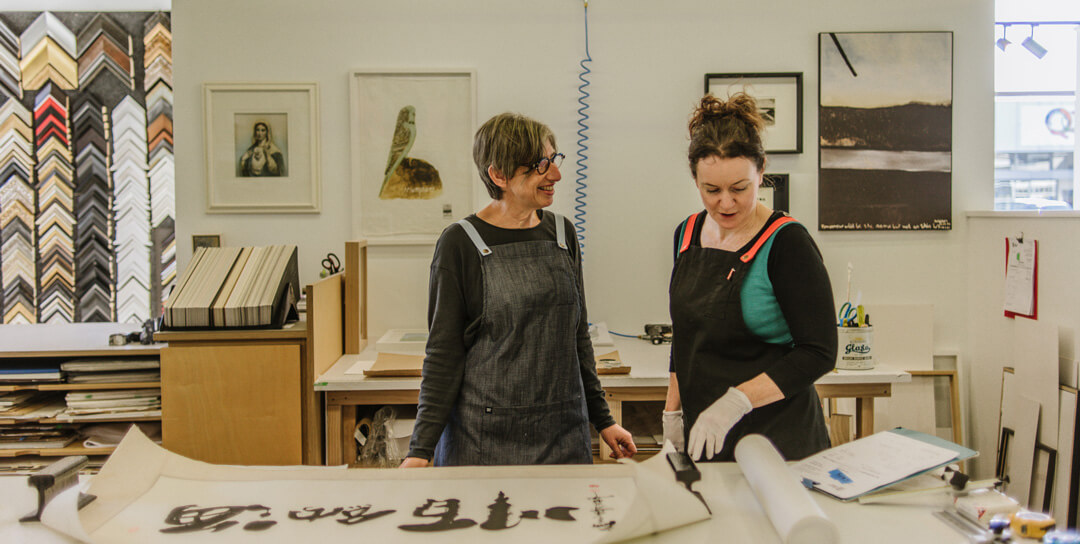Custom Framing Frequently Asked Questions

Picture Framing can seem confusing but we are here to make it easy
Here are a selection of the most commonly asked questions people have. If your question isn’t on the list just give us a call or pop into the workshop to see us face to face.
What do you frame?
The short answer is everything – pretty much! If you want to hang it on your wall we can frame it. There’s the obvious items such as oil paintings, photography, posters, prints, paintings on canvas, sports jerseys, certificates, tea towels, tapestries, medals and other memorabilia. Then there are the more unusual things… for example last year we framed a tiny fish skeleton, a four leaf clover, a tin can and remnants of wallpaper from more than a 100 years ago. We love a challenge so come along with your interesting pieces.
Will my framing be expensive?
We realise that this is a big concern for a lot of people these days and unfortunately the cost of framing has gone up like everything else. We aim to provide customers with the best value for money so let us know when you arrive if you’d like to see the most economical options. The benefit of having your artwork custom framed is that you’ll be investing in quality framing that will last.
You are welcome to give us a call for a quote. We’ll ask you what it is you want to frame, the size and what you have in mind. This will be an estimate which we can confirm when we see you with the actual work you want framed. As a general guide most custom framing starts at around $100 for small, basic jobs. For an A3 print the cost is around $150. You need to budget for around $200 for a certificate and a sports jersey is generally around the $600 mark.
How long will my framing take to do?
We generally work to a two or three week turn-around but let us know if you have a deadline and we will do our best to meet it. If you are an artist framing a series of works for an exhibition it’s a good idea to give us a 6 week head start. We don’t need all your work but it’s a great idea to start talking about ideas and we can order in the materials we are going to need.
Do I need to make an appointment?
You can just come in whenever it suits you. We are open from 9am – 5pm Monday – Friday and on Saturday mornings.
How do I frame a painting on canvas?
Most paintings on canvas are stretched around a pine subframe that keeps the canvas taut. We can do this for you if your canvas is loose. You can hang the canvas on your wall just like this but it can look better if the painting has a tray frame. This is a narrow frame that the canvas sits within. A narrow gap is created so there is space around the painting – just enough so that it seems the work is floating within the frame. This works particularly well for smaller paintings as the frame gives the work more status on the wall. The other advantage is that the frame can hide any messy edges. Take a look on our ideas page
Do I need to use glass on my artwork?
If you have a work on paper, which includes photography, it is recommended that you use glass. The job of the glass is to protect your artwork from insects, dust and any other kinds of damage. The same is true for other fragile surfaces such as textiles. If you are bothered by the reflection caused by glass there is a fabulous anti-glare glass that is now fairly affordable. If you have a painting on canvas, which is usually an acrylic or an oil, then glass is not necessary.
What does it mean when a framer talks about an artwork being ‘floated’
Sometimes an artwork goes right to the edge of the paper and you want to see this detail. Sometimes the paper itself has a torn edge that looks good. Other times an artist may have signed right at the bottom corner and you may want this signature visable. These are all good reasons for the paper not to have a window mat but be ‘floated’ on top of the matboard. Sometimes the work is elevated using an additional layer of foamcore. The artwork is attached at strategic places using conservation tape. The glass should be spaced away from the artwork using spacers inside the frame.
When is it better to use a window mount?
A window inside the mount can be a good way of giving more emphasis to a work. It’s a more formal style so works really well for certificates, watercolours, traditional paintings and memorabilia. The mount keeps paper flat and it gives a few millimetres of space between the glass and the artwork. This is important to avoid issues with condensation.
Do you offer a picture hanging service?
We don’t, but we can put you in touch with someone who can. Steve Bailey (who is one of the team) is able to assist with curating the artworks you want to hang at home as well as actually doing the hanging work.
